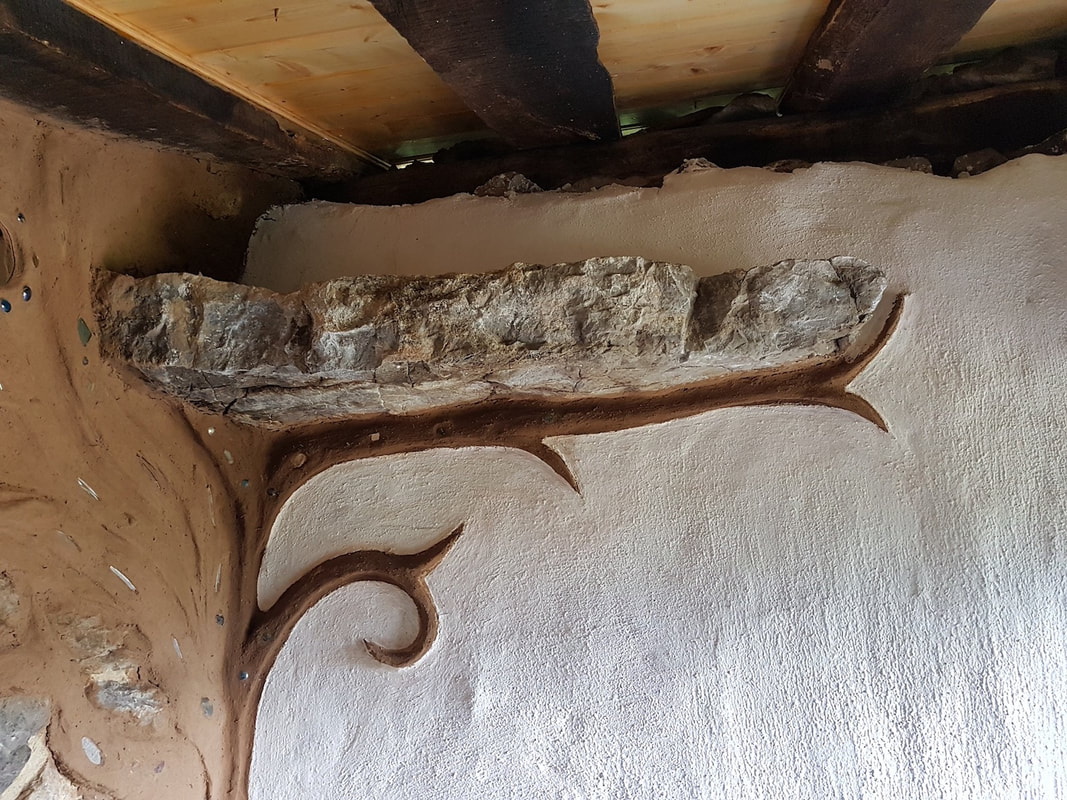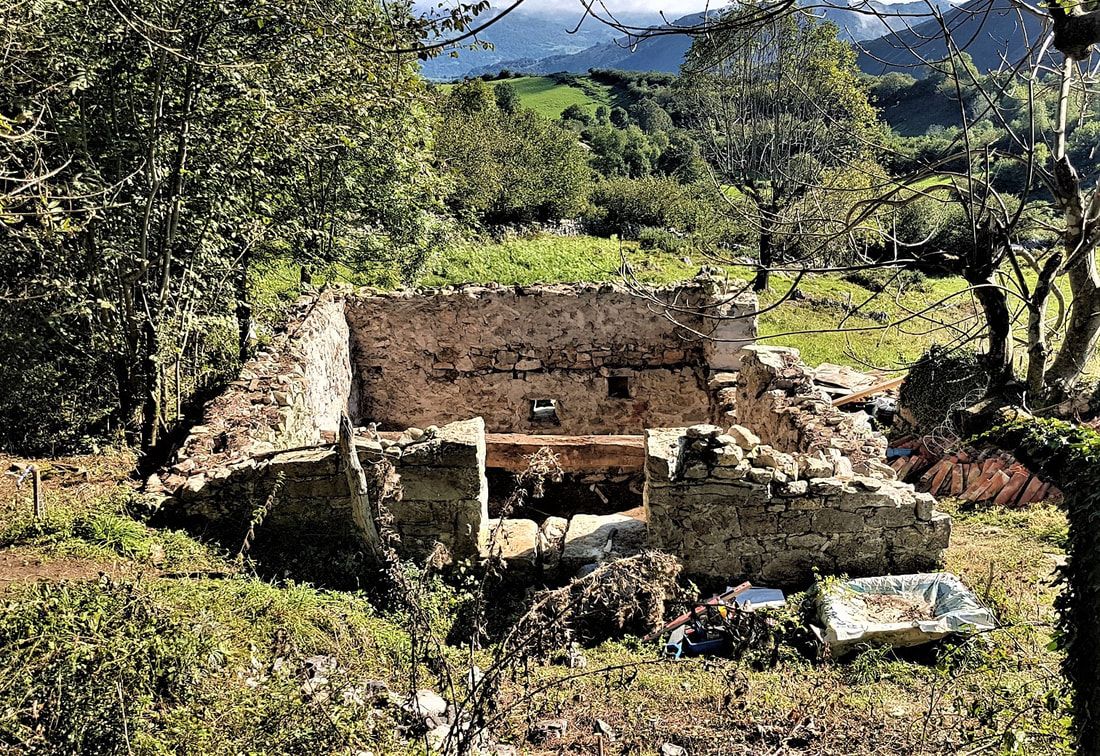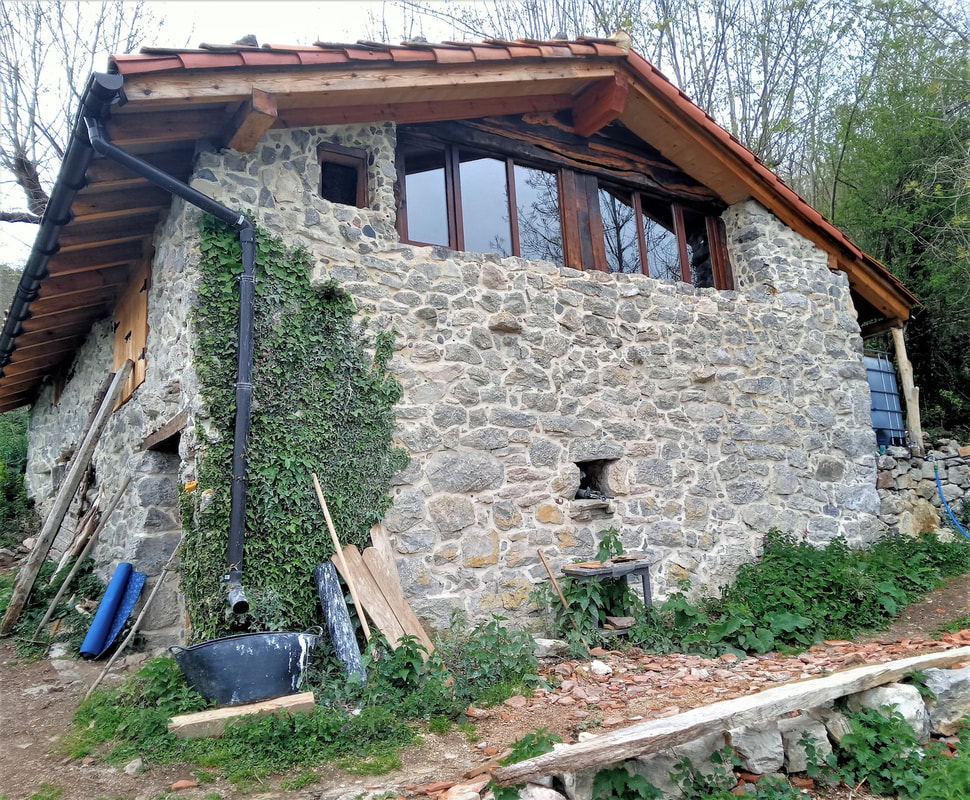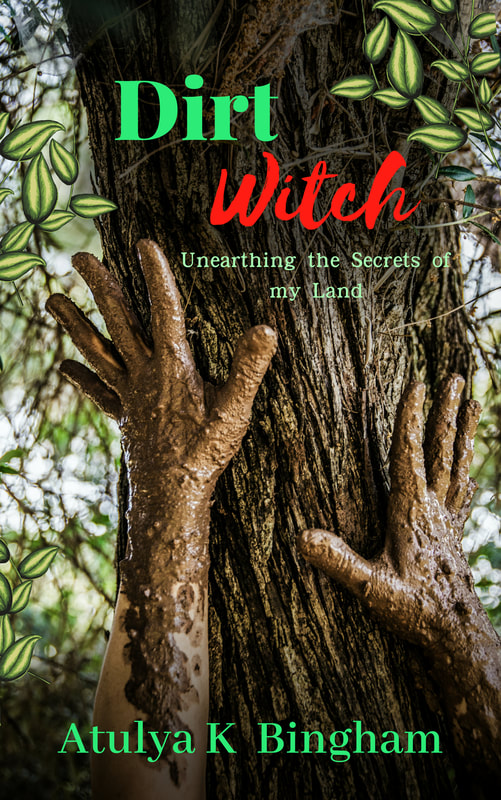|
“People hid here in the civil war,” Farmer Quilo had told me one sun-gilded autumn day the year I moved onto my land. The leaves on the ash trees were starting to shrivel and the landscape was going to seed. “All these barns and huts,” he swept his arm around the yellowing vista like a Wellington boot-wearing emcee. “People ran up here from the town to escape.” I stared at the barns scattered over the hillsides, all in differing states of disrepair, and imagined them harbouring frightened families. None of them contained fireplaces or chimneys, so how did folk survive? “They just lit the fire straight in the hut. Terrible smoke of course. That’s why the wall is black in this one,” he said, pointing at the soot-covered stones in what was to become my temporary kitchen. “Negro, muy negro.” He shook his head. “Hacian queso tambien. Queso ahumado,” he said, pointing to the stone shelves at the top of the wall and explaining how they’d smoked cheeses on them. Unlike many around here, Quilo loves talking about the history of the landscape. He was a miner for much of his life, so he has a penchant for digging below the surface. There are so many stories related to my land, I’ll save the rest for other writings. But suffice to say, the threads of human history run back a fair way with these barns, which are somewhere around 200 years old according to the locals. I’d wanted to renovate an old building since my mud home days in Turkey. I could see it had the potential to be a nature-sensitive way to build. It’s recycle-reuse-repair on a house-size scale after all. A virgin habitat is not being destroyed to make way for yet another human property. The structure already exists. It’s simply unused. Unloved. And in need of some TLC. Right? Yeees. That was my high-minded opinion from the sun-thrashed windows of my mud hut in hot dry southern Turkey. It was a time and place where very little of the old was being salvaged. Indeed one often felt it was deliberately buried. The old was where dark secrets, hardship, and poverty lurked. It was often deemed better to submerge it under a ton of concrete, rather than unearth Allah only knew what. In many ways this is the story of Spain’s lost villages too. Painful histories lurk in the stones and under the terracotta tiles. Though rather than sink them under a dam(n) project or a motorway, the pueblos of Spain’s interior are largely just abandoned. The past is left to rot*. Be Careful What You Wish For: Sooner than I could have ever imagined, my high-minded renovation idea turned into a reality. I left my mud hut in Turkey and moved to the north of Spain. A piece of land drew me to her. It held three ancient huts. The larger structure was an old barn with stone walls wavier than a winter sea. It was a rickety nobbly old thing, stuffed full of musty sheep’s wool, rotting straw, and wolf spiders. The roof was hanging on by the skin of its rotting rafters, tied into existence by a thick bit of wire round an ash tree trunk. I will never forget sitting under one of those ash trees back in 2018, the day before I put in an offer. The moon was exactly half full and half empty, and it rose from the east like a distant ship. As the light drained out of the sky, I stared and stared at the front of the barn. There was a significant crack from top almost to bottom. The walls were splaying outwards. The thing was only surviving out of habit, and the task of repairing it looked utterly impossible. I remember saying to the tree, “I don’t have the money or expertise to do this. It’s a massive job.” I remember the tree replying, “It will all work out, you’ll see.” Thus I bought the land and became the new guardian. But trees aren’t the only ones that talk. Buildings whisper too. They hold the stories of the past just as the land does. Spirits linger in the nooks and corners, while old energies reverberate about the spaces. Did my barn even want to be renovated? Or did he prefer to crumble into the dirt in peace, taking his secrets with him? Once I’d moved onto the land, I sat with my barn. I ran my hands over the old stones. They were choking under the yoke of some of the most poorly applied cement mortar you are likely to see. I sniffed the air and studied the wattled mezzanine where the sheep’s wool was stored. I listened to more stories, and heard more secrets. But my barn never felt creepy to me. What he felt was excited, as though he were looking forward to a bit of razzmatazz and glory. “Ha! I’m your woman!” I said to Barn. “Razzmatazz is my middle name.” Had Barn possessed hands, he would have punched the air. Restoration, Conversion, or Transmutation? It was September 2020 when the roof was ripped off. I had a dream I’d co-formed with my aging stable. He was going to retain his character and still be unabashedly barn-like, yet with majesty and…razzmatazz. But once the roof was off, it became clear Barn was neither straight nor square. At all. He was a trapezium. Some walls were bowing out. Some had no mortar at all and were just resting on the limestone rock of the land. Some still sported the earthen mortars of old. “Is it safe?” I’d asked Brian, who was doing the roof and happened to be an engineer. “It’s been sitting here for two hundred years,” he said. “And if the roof is on, it will no doubt sit a hundred-odd more at the very least.” We scoured the walls and the cracks. It was all sound even if it didn’t look that way at first sight. I breathed a sigh of relief. There would be no need to take walls down and rebuild them. Barn could stay intact, just with a new hat on. There were issues with this of course. Adding a roof to a trapezium meant that somewhere it wouldn’t sit straight. In the end we decided to tilt the roof, so that the east-facing most visible side lined up, but the other side didn’t. Naturally whenever anyone sees it, the first almost parrot-like comment is, “But it’s not straight.” I feel Barn glower. I try not to glower along. Because some things are a lot more important than a straight line. Things like personalities, characters and souls. I don’t want to live in a box. Barn doesn’t want to be a box either! Those stones have been sitting there for two hundred years. They deserve some respect. Nonetheless I worried. Was I doing Barn justice? There were things that didn’t quite go how I wanted, and that I’ll later no doubt change. The plastic drainpipe is sacrilege, but I couldn’t source or transport metal ones, and it was simply too urgent to mess about with rainwater seeping into the interior. Despite these bungles though, when I look at my stonework and mortar work, I feel pride. It took months and months for me to dig out all the old concrete by hand, then mix tons of fresh lime mortar by hand too, and repoint adding bling and sparkle here and there. Non-Aligned So those hoping for a strict restoration will be disappointed. The past doesn’t want to be resurrected here, not even with a bombastic gloss over it. But it doesn’t want to be buried either. Nor forgotten and discarded like a geriatric uncle in a home. It definitely doesn’t want cement thrown all over it. The ghosts need to move on to better futures, and the energies be free to transmute. In fact I don’t think there’s such a thing as a restoration really. All history and all memory is reconstructed every time we think about it. Our pasts are in permanent flux.** However, those hoping for some slick Grand Designs barn conversion thing with modern fads dictating, and the past all painted over, will be disappointed too. This isn’t slick. Or straight. And definitely not fashionable (thank God!). I wouldn’t call it a barn conversion. I’m not into converting anyone to anything, even if people project that onto me. I’m into empowerment and freedom and people standing on their own feet and in their own hearts and connecting with the amazing environment they live in. So you see, this is something else. It’s a barn transmutation. Because barns are beautiful, fundamental, crucial structures in our world. They are earthy and grainy animal places that underpin our very survival. This is a Barn transmutation because Barn has changed me just as much as I’ve changed him, and I see now we are both the better for it. So here we are. I haven’t done it yet. The interior holds more work than I dare contemplate right now, and knowing me I’ll fart-arse around with the exterior plenty more once that’s done. Even so, we narrator-builders must celebrate the completion of an episode. Because that’s what these projects are: long sagas filled with chapters. As I turn this month's page Barn is finally glowing. The non-aligned roof is testimony to the incongruity between modern standards and organic growth. The new windows framed in the old oak roof timbers depict clearly what supports what. And those ancient stone walls built to no code nowhere, without foundations or cement or drainage or damp courses, well...after two hundred years we see. It took a year of repointing by a hag on a hill, but they’re basically as good as the day they were made, supporting a new roof, a new interior floor, and so much more. So Barn is having the last laugh here, with a brand new future ahead that no one ever expected. He isn’t a sad story that’s been run away from, or a shameful secret to be whitewashed. He’s a distinguished outbuilding that has sheltered animals and people and food in hard times, that has survived two world wars, a civil war, Franco, and now even modernity and hyper-capitalism. He has bucked the system and lived to tell the tale. For a while there it looked pretty desperate with the roof all but collapsing on him and no one taking care. But hey, it can all change in an instant in this life of wonders. True he has wonks and bulges and wrinkles and faults, as do I and you. We have lived through many adventures after all. But we are not simply the result of our pasts and definitely not just the victims or perpetrators of them. We are something far wider and broader than our histories, with the possibility to transmute at any minute. Anything can happen. At any time. Turn the page my friends, it’s another chapter. And no, a handful of billionaires are not writing it. Or building it. We are. Every minute. Every day. With everything we do and say. And it looks like we’re neither into restoration nor renovation thank you very much. We’re into transmutation. * This is not a criticism of the coping strategies of largely traumatised populations. None of us wants to scratch off the scab of an old wound. All nations deal with their inevitably uncomfortable pasts in different ways: whitewashing, forgetting, burying, abandoning, or rewriting with pomp and glory and exporting wholesale (like good old England, for example). And all are hyper-sensitive about that fact:) **Oliver Sacks has made plenty of studies on the rather fluid nature of memory, as mentioned in his books, The Man Who Mistook His Wife For a Hat, or An Anthropologist on Mars, or as outlined in brief in the article below. http://www.fmsfonline.org/?news2013update=Oliver%20Sacks%20on%20Memory Do you enjoy these stories? If you enjoy my stories consider joining us on Patreon. Your support pays for the running of this website, my virtual help, and my sustenance. Currently, all patrons have access to my private land report videos which show my progress from day one of building until today. A big thank you to all The Mud Sustainers, and everyone chipping in and keeping these posts and articles coming. In this Earth Whispering exploration I share with you my own experiences and means of hearing the land around me, plus how I follow her nudges. This project is on a tiered funding basis, so you can choose what you pay. Just like all my courses it will be updated and added to as time goes by, so hop on now to get full benefit.
"This really assures me that I’m on the right path and not alone in this way of thinking." -Vin
6 Comments
|
Atulya K Bingham
Author, Lone Off-Gridder, and Natural Builder. Dirt Witch
"Reality meets fantasy, myth, dirt and poetry. I'm hooked!" Jodie Harburt, Multitude of Ones.
Archives
November 2022
Categories
All
|










 RSS Feed
RSS Feed


